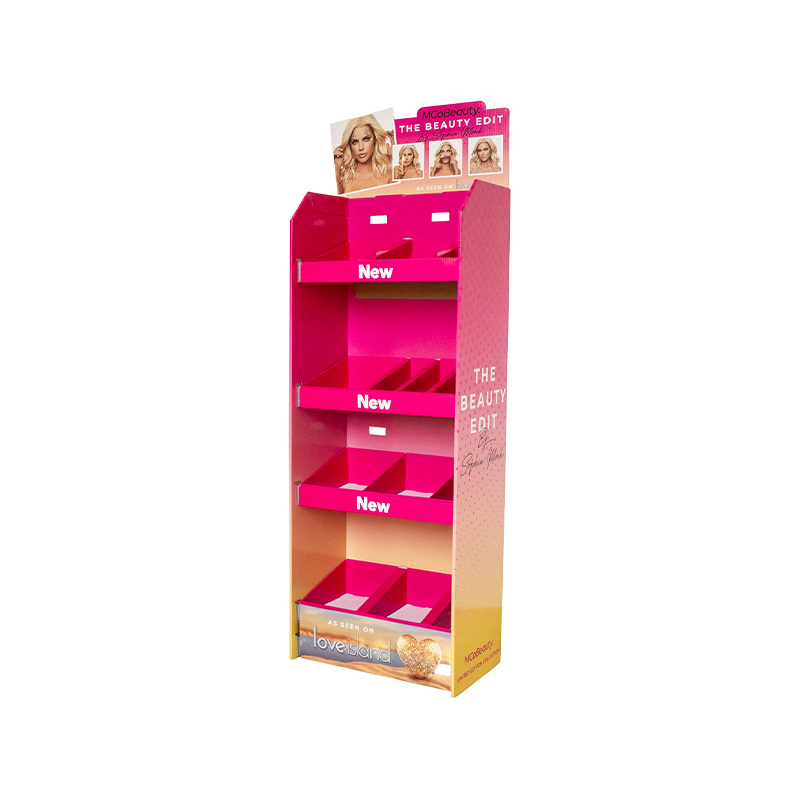-
 +86-0557-3781111 / +86-0571-56396277
+86-0557-3781111 / +86-0571-56396277
 +86-0557-3781111 / +86-0571-56396277
+86-0557-3781111 / +86-0571-56396277
Cardboard display stands play an essential role in product presentation, point-of-sale marketing, and enhancing brand visibility in retail environments. However, not all cardboard displays are created equal. Choosing the right structure can significantly impact both functionality and visual appeal. Factors such as product type, display location, weight capacity, and expected duration of use all contribute to determining the most suitable display structure.
1. Understand the Primary Purpose of the Cardboard Display
Before selecting a structure, clarify the primary objective of the display. Is it to increase impulse buys? Launch a new product? Provide samples? Or hold bulk items for self-service? Each of these goals may require different structural designs:
Countertop Displays are ideal for small, lightweight products at checkout counters.
Floor Displays accommodate larger quantities and can attract customers from a distance.
Pallet Displays are best suited for warehouse-style retail or wholesale environments.
End Cap Displays are placed at aisle ends and are great for seasonal or promotional items.
Understanding the display’s purpose helps narrow down the appropriate design structure and size.
2. Match the Structure with the Type and Size of the Product
The nature of your product is a key factor in choosing the right structure. Consider the following:
Small, lightweight products (cosmetics, snacks, travel-sized items) can be supported by lightweight countertop or tiered displays.
Medium-sized items (bottles, boxed goods, electronics) benefit from peg-hook displays or reinforced floor stands with multiple shelving levels.
Heavy or bulky items (canned goods, household supplies) require double-layered cardboard with internal support structures for extra strength and stability.
Additionally, the number of product units to be displayed at once will influence whether you need a single-face, multi-tier, or compartmentalized structure.
3. Consider the Retail Environment Where It Will Be Placed
The display's effectiveness also depends on where it will be positioned:
Supermarkets: High-traffic aisles may benefit from taller, eye-catching floor displays.
Convenience stores: Space is limited, so compact and easy-to-assemble displays are preferred.
Boutiques or specialty stores: Custom-shaped or uniquely printed displays add a touch of brand sophistication.
Trade shows or pop-up events: Foldable, lightweight, and quick-to-assemble structures are ideal for temporary setups.
Environmental factors like humidity and foot traffic should also be considered, as they can impact the durability and placement of the display.
4. Evaluate the Weight Capacity and Structural Strength
The weight your cardboard display needs to bear directly influences the structural configuration:
For lightweight products, single-wall cardboard with simple die-cut designs may suffice.
For heavier loads, opt for double-wall corrugated cardboard, reinforced base panels, and possibly plastic support rods or metal clips.
Shelves should be equally spaced and securely slotted to avoid sagging or tipping over during use.
Custom-engineered inserts can also be added to stabilize products and keep packaging aligned and tidy on the shelf.
5. Balance Aesthetics with Functionality
While strength and structure are critical, visual design must not be overlooked. A well-designed cardboard display should reflect your brand’s image, align with marketing objectives, and attract customer attention. Structure and aesthetics should work together.
Curved edges, angled shelves, and tiered levels can enhance visibility.
Structural cutouts and compartments can help separate product variations.
Header panels and side wings allow for prominent logo placement and promotional messaging.
Choosing a design that merges function with visual appeal can increase shopper engagement and product interaction.
6. Factor in Ease of Assembly and Transportation
Retailers often prefer displays that are easy to set up and don’t require special tools. Your display structure should ideally:
Be pre-folded or flat-packed for efficient shipping.
Include clear assembly instructions or visual guides.
Minimize the number of separate components.
This is particularly important for nationwide promotional campaigns, where displays are distributed in bulk across many store locations.
7. Work with an Experienced Display Manufacturer
An experienced cardboard display supplier can help you choose or customize the right structure based on your specific product and business needs. Manufacturers can recommend structural reinforcements, material grades, and custom die-cut shapes to optimize both strength and brand presentation.
When selecting a manufacturer, consider their ability to handle short runs, bulk orders, and offer sustainable materials. Some providers also offer digital prototyping or 3D visualizations to help you preview the structure before mass production.

Choosing the right structure for your cardboard display stand is more than just a design decision—it’s a strategic move that impacts product visibility, sales potential, and customer experience. By aligning the display’s structure with your product type, retail setting, and branding goals, you can maximize both form and function.
Annhiu Address: Yishan Road and Qingshengou Road Intersection, Suzhou Economic Development Zone, Anhui, China
Tel: +86-0557-3781111
E-mail: [email protected]
Hangzhou Address: Building 3, No.286, Renliang Road, Renhe Street, Yuhang District, Hangzhou, Zhejiang, China
Tel: +86-0571-56396277
E-mail: [email protected]
Copyright © Hangzhou Shengpin Packaging Co., Ltd. All Rights Reserved.
